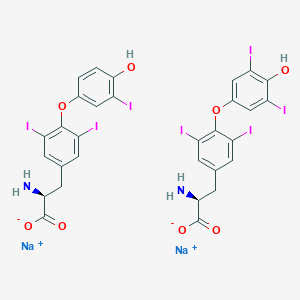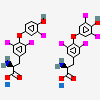Liotrix
- Liotrix
- Euthroid
- Combithyrex
- Thyrolar
- Diotroxin
- Create:2005-06-24
- Modify:2025-01-18

- Euthroid
- Euthyral
- liotrix
- Thyreotom
- Thyrolar
- thyroxine - triiodothyronine combination
- thyroxine - triiodothyronine combination, monosodium salt
- thyroxine, triiodothyronine drug combination
- triiodothyronine - thyroxine combination
- Liotrix
- Euthroid
- Combithyrex
- Thyrolar
- Diotroxin
- 8065-29-0
- Liotrix (T4;T3)
- Liotrix [USAN:USP]
- UNII-YW8HJ0N26X
- YW8HJ0N26X
- Liothyronine Sodium and Levothyroxine Sodium
- W 1782
- Liotrix (USAN:USP)
- Novothyral
- disodium;(2S)-2-amino-3-[4-(4-hydroxy-3,5-diiodophenoxy)-3,5-diiodophenyl]propanoate;(2S)-2-amino-3-[4-(4-hydroxy-3-iodophenoxy)-3,5-diiodophenyl]propanoate
- L-Tyrosine, O-(4-hydroxy-3,5-diiodophenyl)-3,5-diiodo-, monosodium salt, mixt. with O-(4-hydroxy-3-iodophenyl)-3,5-diiodo-L-tyrosine monosodium salt
- Monosodium L-thyroxine hydrate mixt. with monosodium L-3-(4-(4-hydroxy-3-iodophenoxy)-3,5-diiodophenyl)alanine
- LIOTRIX (USP IMPURITY)
- LIOTRIX [USP IMPURITY]
- Liotrix [USAN]
- disodium (2S)-2-amino-3-(4-(4-hydroxy-3,5-diiodophenoxy)-3,5-diiodophenyl)propanoate (2S)-2-amino-3-(4-(4-hydroxy-3-iodophenoxy)-3,5-diiodophenyl)propanoate
- disodium (2S)-2-amino-3-[4-(4-hydroxy-3,5-diiodophenoxy)-3,5-diiodophenyl]propanoate (2S)-2-amino-3-[4-(4-hydroxy-3-iodophenoxy)-3,5-diiodophenyl]propanoate
- CHEBI:6485
- DTXSID401001390
- thyroxine-triiodothyronine combination
- Triiodothyronine-thyroxine combination
- DB01583
- LIOTRIX (T4;T3) [ORANGE BOOK]
- L-Tyrosine, O-(4-hydroxy-3,5-diiodophenyl)-3,5-diiodo-, monosodium salt, hydrate, mixt. with O-(4-hydroxy-3-iodophenyl)-3,5-diiodo-L-tyrosine monosodium salt
- Q6556102
- thyroxine-triiodothyronine combination, monosodium salt
- MIXTURE OF LIOTHYRONINE SODIUM AND LEVOTHYROXINE SODIUM, IN A RATIO OF 1:1 IN TERMS OF BIOLOGICAL ACTIVITY, OR IN A RATIO OF 1:4 IN TERMS OF WEIGHT
- Sodium (S)-2-amino-3-(4-(4-hydroxy-3,5-diiodophenoxy)-3,5-diiodophenyl)propanoate mixt. with sodium (S)-2-amino-3-(4-(4-hydroxy-3-iodophenoxy)-3,5-diiodophenyl)propanoate
◉ Summary of Use during Lactation
Liotrix is a mixture of levothyroxine (T4) and liothyronine (T3), which are normal components of human milk. Limited data on exogenous replacement doses of levothyroxine during breastfeeding indicate no adverse effects in infants. No information is available on the use of exogenous liothyronine during breastfeeding. The American Thyroid Association recommends that subclinical and overt hypothyroidism should be treated with levothyroxine in lactating women seeking to breastfeed. Thyroid dosage requirement may be increased in the postpartum period compared to prepregnancy requirements patients with Hashimoto's thyroiditis.
◉ Effects in Breastfed Infants
Effects of exogenous thyroid hormone administration to mothers on their infant have not been reported. One case of apparent mitigation of cretinism in hypothyroid infants by breastfeeding has been reported, but the amounts of thyroid hormones in milk are not optimal, and this result has been disputed. The thyroid hormone content of human milk from the mothers of very preterm infants appears not to be sufficient to affect the infants' thyroid status. The amounts of thyroid hormones in milk are apparently not sufficient to interfere with diagnosis of hypothyroidism.
In a telephone follow-up study, 5 nursing mothers reported taking levothyroxine (dosage unspecified). The mothers reported no adverse reactions in their infants.
One mother with who had undergone a thyroidectomy was taking levothyroxine 100 mcg daily as well as calcium carbonate and calcitriol. Her breastfed infant was reportedly "thriving" at 3 months of age.
◉ Effects on Lactation and Breastmilk
Adequate thyroid hormone serum levels are required for normal lactation. Replacing deficient thyroid levels should improve milk production caused by hypothyroidism. Supraphysiologic doses would not be expected to further improve lactation.
Patents are available for this chemical structure:
https://patentscope.wipo.int/search/en/result.jsf?inchikey=LKYWLLWWYBVUPP-XOCLESOZSA-L
- Avoid calcium supplements/calcium rich foods. Calcium may interfere with the absorption of this drug by forming an insoluble complex. Separate medication administration by at least 4 hours.
- Avoid grapefruit products. Grapefruit may delay the absorption of this medicaiton.
- Avoid high-fiber foods. High-fiber foods may affect absorption. Separate medication administration by at least 1 hour.
- Avoid iron supplements. Iron may interfere with the absorption of this drug by forming an insoluble complex. Separate medication administration by at least 4 hours.
- Avoid multivalent ions. Avoid iron and calcium containing products as well as antacids.
- Take before a meal. Take 30-60 minutes before breakfast.
- Take on an empty stomach.
- ChEBI
- DrugBankLICENSECreative Common's Attribution-NonCommercial 4.0 International License (http://creativecommons.org/licenses/by-nc/4.0/legalcode)https://www.drugbank.ca/legal/terms_of_use
- ChemIDplusLevothyroxine Sodium mixture with Liothyronine Sodiumhttps://pubchem.ncbi.nlm.nih.gov/substance/?source=chemidplus&sourceid=0008065290ChemIDplus Chemical Information Classificationhttps://pubchem.ncbi.nlm.nih.gov/source/ChemIDplus
- EPA DSSToxCompTox Chemicals Dashboard Chemical Listshttps://comptox.epa.gov/dashboard/chemical-lists/
- Drugs and Lactation Database (LactMed)
- Drugs@FDALICENSEUnless otherwise noted, the contents of the FDA website (www.fda.gov), both text and graphics, are not copyrighted. They are in the public domain and may be republished, reprinted and otherwise used freely by anyone without the need to obtain permission from FDA. Credit to the U.S. Food and Drug Administration as the source is appreciated but not required.https://www.fda.gov/about-fda/about-website/website-policies#linking
- FDA Orange BookLICENSEUnless otherwise noted, the contents of the FDA website (www.fda.gov), both text and graphics, are not copyrighted. They are in the public domain and may be republished, reprinted and otherwise used freely by anyone without the need to obtain permission from FDA. Credit to the U.S. Food and Drug Administration as the source is appreciated but not required.https://www.fda.gov/about-fda/about-website/website-policies#linking
- Metabolomics Workbench
- NCI Thesaurus (NCIt)LICENSEUnless otherwise indicated, all text within NCI products is free of copyright and may be reused without our permission. Credit the National Cancer Institute as the source.https://www.cancer.gov/policies/copyright-reuseNCI Thesaurushttps://ncit.nci.nih.gov
- PharmGKBLICENSEPharmGKB data are subject to the Creative Commons Attribution-ShareALike 4.0 license (https://creativecommons.org/licenses/by-sa/4.0/).https://www.pharmgkb.org/page/policies
- Springer Nature
- Wikidata
- PubChem
- Medical Subject Headings (MeSH)LICENSEWorks produced by the U.S. government are not subject to copyright protection in the United States. Any such works found on National Library of Medicine (NLM) Web sites may be freely used or reproduced without permission in the U.S.https://www.nlm.nih.gov/copyright.htmlthyroxine, triiodothyronine drug combinationhttps://www.ncbi.nlm.nih.gov/mesh/67018539
- MolGenieMolGenie Organic Chemistry Ontologyhttps://github.com/MolGenie/ontology/
- PATENTSCOPE (WIPO)SID 388954065https://pubchem.ncbi.nlm.nih.gov/substance/388954065

 CID 5819 (Levothyroxine)
CID 5819 (Levothyroxine) CID 5920 (Liothyronine)
CID 5920 (Liothyronine) CID 5360545 (Sodium)
CID 5360545 (Sodium)